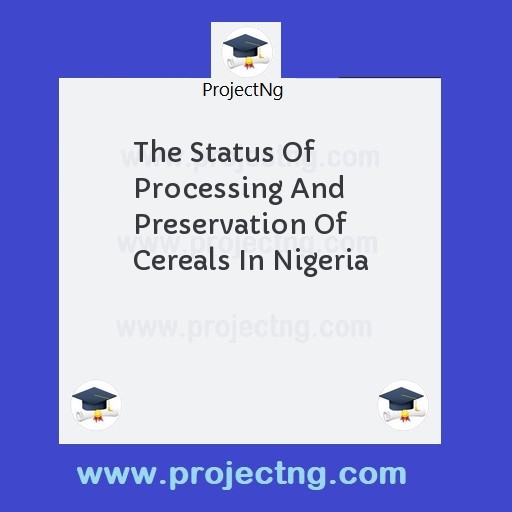The Status Of Processing And Preservation Of Cereals In Nigeria
Food Technology Project Topics
Get the Complete Project Materials Now! »
THE STATUS OF PROCESSING AND PRESERVATION OF CEREALS IN NIGERIA
TABLE OF CONTENTS
Title page
Approval page
Dedication
Acknowledgement
Table of contents
CHAPTER ONE
1.0 Introduction
CHAPTER TWO
2.0 Brief Description Of Various Types Of Cereals
2.1 Maize
2.2 Sorghum And Mihet
2.3 Cotton Seed Meal
2.4 Rice
2.5 Wheat
2.6 Nutritive Values Of Various Types Of Cereals
2.7 The Processing Of Various Types Of Cereals And It’s Uses To Mankind
2.8 Microbial Effects On Cereals
2.9 Preservation/Storage
CHAPTER THREE
3.0 Conclusion
REFERENCES
CHAPTER ONE
1.0 INTRODUCTION
Of all the plant on which man has depended for his food, cereal grains are by far the most important. Since recorded history, cereals grains are the seed by cultivated grasses that include wheat, corn, 0at, barley, rye, rice, sorghum and millet.
There are a number of reasons why cereals have been important in man’s diet. They can be grown in areas with diverse climatic and soil conditions. They give yield peracre (0.4ha) as compared to most other crops and once harvested, their excellent storage stability combined with their high nutritive valuers make them most suitable for storage.
They are easy to be packaged and transported and can be used to produce a large variety of high desirable foods both for man and animals.
Cereal grains are the most important source of the world’s total food. The grains are eaten in many ways, sometimes as a paste or other preparation of the seeds more often milled and further processed into flour, starch, oil, bran, syrup, sugar, etc. They are also used to feed the animals that provide us with meat, eggs, millet, butter, cheese and a host of other foods. Cereals grains are preserved in ways which make them to last long for processing.
CHAPTER TWO
2.0 BRIEF DESCRIPTION OF VARIOUS TYPES OF CEREALS
The group name cereals embraces among others of the following, maize, sorghum, millet, rice, wheat, and cotton seed.
2.1 MAIZE OR CORN
Maize grain is larger than other cereals, possessing a broad apex and a narrow base. The starching endosperm, germ and large scutellum are contained with a hull comprising the pericarp and test a. the starch endosperm is of two types.
(a) The soft endosperm which consist of mainly starch granules.
(b) Horny endosperm which is mainly gluten.
Maize is a good source of vitamin B but is deficient in vitamin A, B3, C and in vitamin D, expect for germinated grains and yellow corn which has more of vitamin C and carotene respectively. Maize is often used as animal folder, but a variety known as yellow corn is grown widely for human consumption. It is eaten fresh, canned, frozen and corn meal breakfast etc.
2.2 SORGHUM AND MILLET
Sorghum is known as guinea corn in West Africa, Kaffir corn in South Africa, Ntama in East Africa and Dura in the North-Eastern part of Africa. The seed is spherical in shape and smaller than maize. It ranks second to maize in total available energy among the cereal grains. Sorghum and milet are the source of energy and protein to humanity. They serve as staple food in many parts of Africa, Asia, Central America and the Arab countries of the middle East and also serve as the main source of beverages in some countries.
Be the First to Share On Social

Enjoying our content?
Don't miss out on new videos! Subscribe to our YouTube channel for more awesome content.
Subscribe Now!













